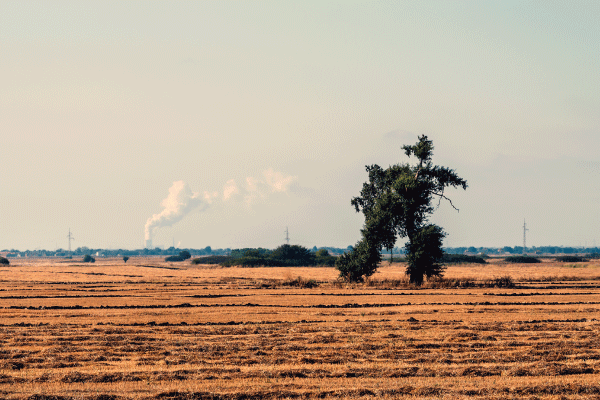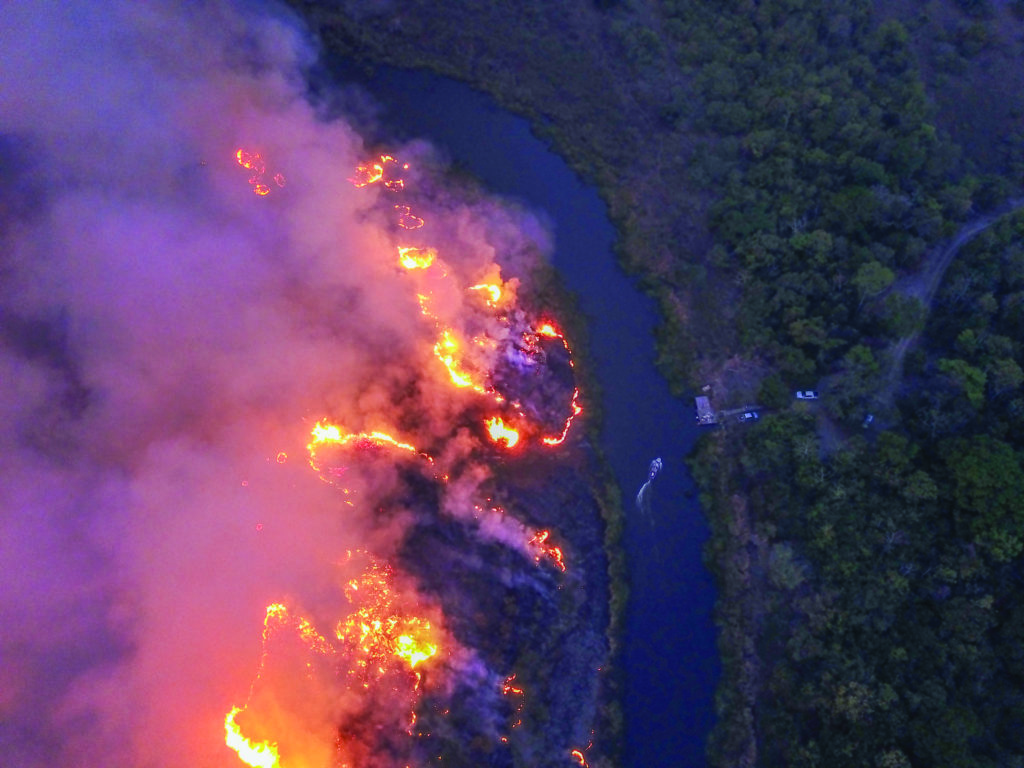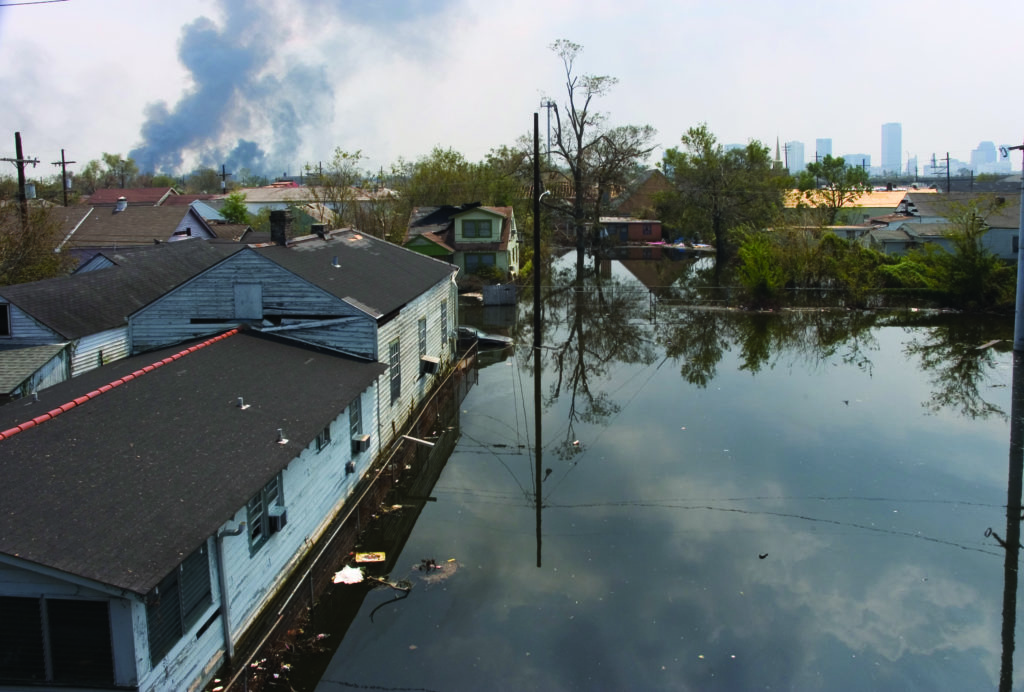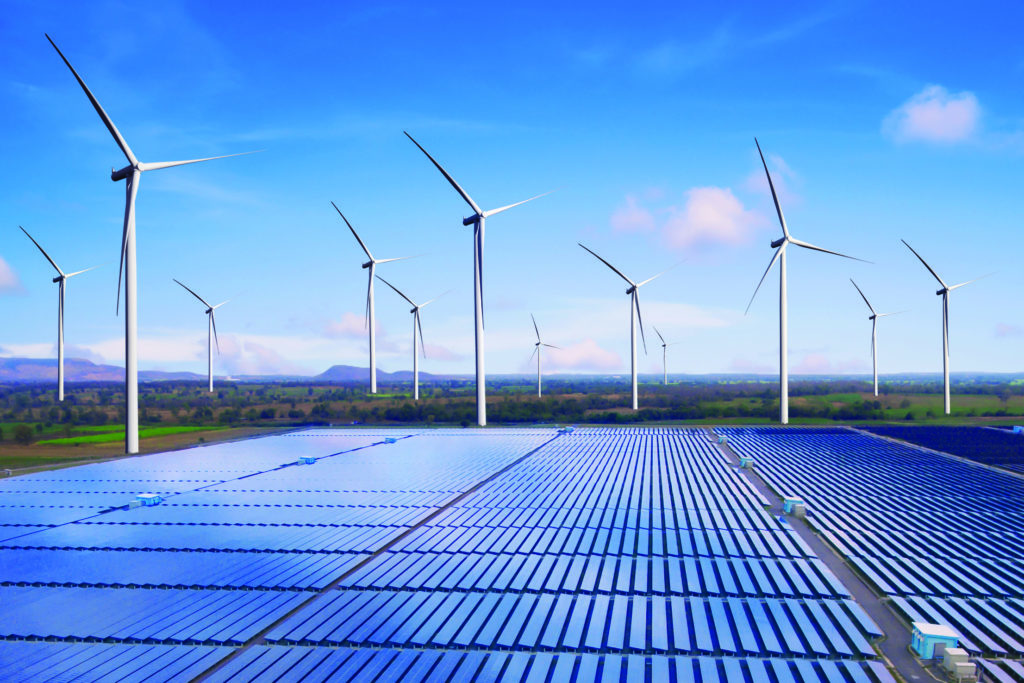Featured
Surviving Ourselves When the Climate Changes

Image: The World Health Organization estimates that air pollution causes 7 million premature deaths every year. Bulgaria, where this photo was taken, has the highest rate of these deaths in Europe.
From heat waves in Greenland to flooding in Kenya, the climate is changing. As temperatures increase, ice caps melt, oceans get warmer, sea levels rise, precipitation patterns change, and climate-related disasters pile up, humans’ physical and mental health is endangered, too.
Addressing Climate Change and Its Psychological, Ethical, and Socioeconomic Challenges
A panel discussion on this topic will be held during the 2021 APS Virtual Convention, May 26–27, 2021.
The negative effects of climate change disproportionately affect populations that are more vulnerable because of their locations, inadequate infrastructures, or demographic characteristics, but everyone is at risk. The World Health Organization (WHO) has stated that climate change affects many of the social and environmental determinants of health, including clean air, safe drinking water, sufficient food, and secure shelter. And the U.S. Global Change Research Program, in a 2016 report, noted that through interactions with health, demographic, and socioeconomic factors, climate change exacerbates existing health threats and creates new public health challenges.
Psychological science has helped reveal how exposure to the consequences of climate change affects people’s mental health. Researchers in diverse fields of psychology have also studied individuals’ preparation for and responses during disasters so that fewer people will have to experience them. Moreover, psychological science sheds light on the complexity of human decision-making and the social and environmental factors that affect the behavioral changes needed to slow down climate change and its consequences. Here’s a look at what the science tells us about what happens after, during, and before natural disasters.

Climate change and natural disasters
Natural disasters, which are often a direct result of climate change, can have profound effects on individuals and communities. Take 2020’s massive wildfires in California, Brazil, and Australia. In California, 9,639 fires burned 4,397,809 acres, destroyed more than 10,000 structures, and caused $12 billion in damages. The fires in the wetlands of Pantanal in Brazil, three times as large as those the year before, put local Indigenous communities and Brazil’s unique wildlife at risk. Australia’s 2019–2020 bushfires killed or displaced nearly 3 billion animals, destroyed more than 5,900 buildings (including 2,779 homes), and killed at least 34 people.
In addition to causing material losses, climate disasters take a toll on physical and mental health. In 1667, diarist Samuel Pepys described his lingering fear, distress, and anxiety after the Great Fire of London 6 months earlier. In 2010, APS James McKeen Cattell Fellow George A. Bonanno (Columbia University) and colleagues wrote that the consequences of disasters can include posttraumatic stress disorder, grief, depression, anxiety, stress-related health costs, substance abuse, and suicidal ideation.
Climate Change: The Facts
Climate change has been accelerated by human activities, especially the burning of fossil fuels, that have released carbon dioxide and other greenhouse gases in high enough quantities to trap heat in the lower atmosphere, leading to global warming. According to the WHO, in the last 130 years, the world has warmed by approximately 1.53 degrees Fahrenheit (0.85 degrees Celsius). Although this level of warming might not seem like much, it is enough to change precipitation patterns and increase the frequency and intensity of extreme weather events. The number of reported weather-related natural disasters has more than tripled since the 1960s, and these disasters result in over 60,000 deaths every year. In a fact sheet about climate change and health, the WHO reported that:
- Extreme heat contributes directly to deaths from cardiovascular and respiratory disease, particularly among elderly people, and exacerbate cardiovascular and respiratory disease.
- Extreme heat increases the levels of pollen and other allergens, which can trigger asthma.
- Rising sea levels and increasingly extreme weather events will destroy homes, medical facilities, and other essential services. Given that more than half of the world’s population lives within 37 miles (60 km) of the sea, many people may be forced to move.
- Increasingly variable rainfall patterns are likely to affect the supply of fresh water. This can compromise hygiene and increase the risk of diarrheal disease, which kills more 500,000 children younger than 5 every year.
- Variable precipitation and rising temperatures can lead to drought and affect food production, increasing risk of famine and malnutrition, which currently causes 3.1 million deaths every year.
- Floods and extreme precipitation can contaminate freshwater supplies, heighten the risk of water-borne diseases, and create breeding grounds for disease-carrying insects such as mosquitoes.
- Changes in climate are likely to lengthen the transmission seasons and expand the geographic range of deadly vector-borne diseases.
However, although climate disasters can cause trauma and psychological problems, they can also reveal resilience—the ability to return to the predisaster status quickly.
After a disaster: Distress and resilience
In their article, published in Psychological Science in the Public Interest, Bonanno and colleagues analyzed the most scientifically sound research and concluded that although people exposed to disasters show diverse psychological problems, fewer than 30% of these individuals experience severe levels of these problems. More than half experience only transient distress, maintain a stable trajectory of healthy functioning, and recover their psychological equilibrium within 1 or 2 years, if not sooner. In his James McKeen Cattell Fellow Award Address at the 31st APS Annual Convention in 2019, Bonanno reinforced the idea that the “resilience trajectory is not only most common, it’s the majority.”
Bonanno and colleagues also concluded that unique risk and resilience factors can inform individual differences in disaster outcomes. Factors relate to the context in which the disaster occurs, proximity to the disaster, and the disaster’s aftermath. For instance, disaster survivors often receive immediate support from their families, relatives, and friends. For this reason, many survivors subsequently claim that the experience brought them closer together, Bonanno and colleagues wrote.
However, the stress of disasters can also erode interpersonal relationships and sense of community, the researchers warned, even among people hundreds or thousands of miles from a disaster’s geographic location. Psychopathology is likely only among populations with preexisting susceptibility (e.g., prior trauma or psychiatric illness) or actual remote exposure (e.g., loss of a loved one in the disaster).
Robin Goodwin (University of Warwick, England) and colleagues examined psychological distress in the years following the March 2011 Great East Japan Earthquake, tsunami, and nuclear leak. In their 2020 study, published in Clinical Psychological Science, the researchers found results similar to those described by Bonanno: Most individuals were resilient. Annual surveys of 2,599 survivors, from 2012 to 2016, showed four trajectories of distress: 76% were resilient, with consistently low distress; 8% experienced delayed distress, characterized by low distress at first that increased over time; 8% were in recovery, with high distress at first that decreased over time; and 7% experienced chronic, consistently high distress. Resilient individuals tended to have more social support than the others. Another finding was that the individuals in the recovery group were more likely to live in prefabricated housing than those in the other groups, indicating that an individual’s physical context can influence how they are affected by and respond to disasters.
As noted, the survivors showed different postdisaster trajectories, including varied levels of distress and paths to resilience. Individual differences not only play a role in shaping these trajectories but also appear to contribute to determining who is likely to survive a disaster in the first place—and who is not.
During a disaster: Fight, flight, or freeze
In her book The Unthinkable, published in 2008, journalist Amanda Ripley talked to disaster survivors and scientists to understand the thought processes of people who are more likely to survive extreme events, including Hurricane Katrina in New Orleans in 2005. “If we get to know our disaster personalities before the disaster, we might have a slightly better chance of surviving,” Ripley wrote.

Experiencing a disaster leads to a three-phase process, Ripley proposed: denial, deliberation, and the decisive moment. Denial is the initial shock phase and can take the form of delay in responding. The time spent in denial is affected by how an individual calculates risks. After denial, a phase of deliberation settles in, where individuals must make decisions while facing the abnormality of the situation and dealing with fear. Finally, in the decisive moment, people take action—they can panic, freeze, or save themselves—and potentially others.
People who are more aware of their true risks have better chances of surviving an extreme event because they are less likely to spend time in denial, Ripley suggested. Awareness of the tendency to engage in denial could motivate a person to plan ahead, before a disaster, to avoid panicking or freezing. The issue is that humans are known for making biased judgments and miscalculating risks (e.g., Kahneman & Tversky, 1979). Therefore, beyond awareness of true risks, understanding how one might react when scared might help increase survival. Ripley cited neuroscience research supporting the idea that people who recognize their responses to fear might find it easier to control their emotions and take the right actions at the right time during an extreme event. Knowing one’s bodily instincts and anxiety patterns or tendency to panic might also help one respond appropriately to disasters.
Before the disaster: Prepare and warn
In fact, a person’s response to a disaster often starts before the event itself, such as with a weather advisory. Floods, earthquakes, and storms can usually be predicted. Having a plan for dealing with natural disasters can influence survival.
Dennis Mileti, who passed away this January, was the former head of the Natural Hazards Center at the University of Colorado Boulder and an expert in disaster communication. In his 1999 book, Disasters by Design: A Reassessment of Natural Hazards in the United States, he discussed how demographic, climate, social, and individual factors have influenced losses from and management of disasters. He also suggested shifts in thinking about natural hazards to facilitate coping with natural disasters and reduce their costs. His proposed approaches: (a) adopting a global systems perspective, (b) accepting human responsibility for disasters, (c) anticipating ambiguity and change, (d) rejecting short-term thinking, (e) taking a broader view of social factors and their role in disasters, and (f) embracing the principles of sustainable development, defined as increasing a community’s ability to overcome damage, diminished productivity, and reduced quality of life from an extreme event without significant outside assistance.
In a 2018 talk prepared for the Federal Emergency Management Agency, Mileti also called to modernize public warning messaging. He suggested five strategies for effective communication around disasters:
- Focus first on alerts for imminent events.
- Remove delays from warning systems, such as issuance and dissemination delays.
- Create detailed plans (e.g., specify the observations used to identify threats and corresponding threat levels, along with options for protective action, such as evacuation routes or areas to avoid).
- Disseminate warning messages wisely, using multiple channels and a mix of technologies so that they can reach multiple populations more quickly.
- Issue messages that reduce delays. For instance, provide details that mitigate the natural human impulse to search for more information before taking protective actions.
Public warnings, Mileti clarified, should provide the information people might be inclined to search for before taking protective action. Messaging content, style, and frequency of delivery appear to highly influence the public’s response to warnings. He recommended that messages be specific (e.g., “If you are between the river and First Street, move north of Main Street” instead of “Evacuate if you are near the river”) and clear (e.g., “A wave of water 20 feet high is moving faster than a person can run” instead of “A 10,000 cubic-feet-per-second flow is moving at 20 feet per second”). Mileti also suggested that messages should convey the source of the warning, the hazard, personalized location information, potential consequences, information on protective action—including what people can do, how long they have to do it, and why it will work—and the warning’s expiration time.
Reducing energy use
Environmental motivations can influence energy-saving behaviors at the individual level, but most research has focused on financial motivations such as lower utility bills, according to psychological scientist Elke Weber. Weber and colleagues have found that messages conveying environmental as well as financial benefits lead to higher energy savings than messages conveying only financial benefits. It helps to align these benefits with participants’ political affiliations: Climate change messages worked best for liberals, whereas stewardship/independence messages worked best for conservatives.
Weber and colleagues are now studying a range of nonfinancial motivations for energy-saving behaviors across the political spectrum and examining what motivations are most strongly linked to existing energy-saving behaviors. In a final phase of the project, they will test whether their findings translate from the lab to real-world environments. Findings from this project will help shape the messages that used to motivate behavior change and promote behavior change.
Behavioral changes to fight climate change
Understanding that climate change is one of the key causes of natural disasters can not only improve people’s chances of surviving but also encourage sustainable behaviors that might help to slow climate change and, consequently, the frequency of natural disasters.
APS Fellow Elke Weber (Princeton University) has studied how psychological science can help individuals and policymakers design decision environments that capitalize on human capabilities and goals to make wise decisions, including those impacting sustainability and the quality of the natural environment. Climate change demands behavioral change, she wrote in a 2015 article published in Social Research. “It is helpful and, in fact, imperative to consider and use the full range of human motivations and goals and the full range of decision processes available to Homo sapiens as we consider action and behavior change in the context of climate change.”
Although climate change is undeniably happening, there is still uncertainty about its consequences and the most appropriate actions. Individuals might focus on uncertainties inherent to specific predictions about climate change and to use them as an excuse to delay action. Yet humans are proactive in protecting against other uncertain scenarios—for instance, in buying car and home insurance. Paul Slovic (1987) showed that when individuals perceive a threat as temporally closer and more personally relevant, they are more likely to take actions to protect themselves.
Informing the public about the threats posed by climate change might not be enough, however. Research has also shown that humans are creatures of habit who learn by trial and error and use shortcuts and emotions to make decisions. These heuristics are, in many cases, more efficient than analytical risk analyses involving complicated calculations (e.g., see Gigerenzer & Selten, 2002). But in other instances, they might hinder necessary change.
Weber highlighted the importance of considering the broad number of goals that humans have. “The problem is typically not that we do not know what we want; instead decisions are often difficult because we want too many and at times conflicting things,” she wrote. Because of limited attention, humans are also prone to oppose change—a preference known as status quo bias. All of these factors—multiple competing goals, status quo bias, and the human tendency to focus on here and now, including costs in the service of future benefits—undermine climate change action.
Weber suggests three strategies for facilitating behavior change: making sustainable options the default, so that choosing unsustainable options requires action; changing the status quo itself, so that individual resistance to change works in favor of sustainable action; and rephrasing and reframing choice option labels in a manner that nudges individuals to make environmentally sound choices (e.g., individuals might be more willing to pay a “carbon offset” fee than a “carbon tax”). In addition to these strategies, focusing on the positive consequences of actions might foster needed responses to climate change. “This may involve a new conceptualization of human happiness… away from the current model that is consumption based which puts us on a hedonic treadmill and endangers the global climate and environment,” wrote Weber.
Another strategy to increase engagement with climate change and other environmental problems appears to be emphasizing individuals’ motivation to leave a positive legacy. In a 2015 study in Psychological Science, Weber and colleagues Lisa Zaval (Columbia University) and Ezra M. Markowitz (University of Massachusetts Amherst) found that individual differences in legacy motivation were positively associated with proenvironmental behaviors and intentions. Moreover, when the researchers made legacy motivations salient, participants increased their donations to an environmental charity and demonstrated more proenvironmental intentions and climate change beliefs.

Importance of the social and physical environment
“Human decisions, and in particular decisions that impact sustainability and the quality of our natural environment, are made within a social and physical context,” Weber has written on her website. Currently, she is researching the success of interventions aimed at changing perceptions of social norms. With participants from different countries, including the United States, Italy, China, and India, the researchers will study the longevity and cross-cultural generalizability of such interventions. “By tracking perceptions, attitudes, perceived social norms, and behavior with respect to climate change, air pollution, or other environmental hazards, we can track the sensitivity of these variables towards variations in the physical and social environment and can measure immediate and long-term effects of top-down signals hypothesized to influence behavior via changed perceptions of social norms,” Weber explained.
In another study, Weber and colleagues are investigating the factors that influence perceptions of social norms. Their hope is to address coordination problems posed by global challenges such as climate change. Specifically, the researchers are examining how similar institutional signals from different sources, such as governments, business organizations, and scientific agencies, affect perceptions of social norms, individual attitudes, and behavior.
Sander van der Linden (University of Cambridge) has also emphasized the role of social norms in responses to climate change, putting forward a social-psychological model of climate change risk perceptions in a 2015 paper in the Journal of Environmental Psychology. By testing the climate change risk perception model (CCRPM) in a large sample of the U.K. population, van der Linden found that predictors of climate change risk perception include gender, political party, social norms, value orientations, negative affect, and personal experience with extreme weather events, along with knowledge of the causes, impacts, and responses to climate change. Moreover, he found that sociocultural and experiential factors were better predictors of perceived risk than cognitive or sociodemographic factors.
Given these results, van der Linden suggested that “risk messages are likely to be more effective when they not only provide people with increased knowledge of the causes, consequences and solutions to climate change, but also appeal to affective and experiential processing mechanisms whilst being sensitive to different sociocultural value orientations.”
Overall, van der Linden’s results suggest that perceptions of climate change risks are complex and multidimensional, and that risk communication might be more efficient when it appeals to multiple aspects of human judgment and behavior.
What should policymakers do to improve individuals’ and communities’ engagement with climate change and, ultimately, improve sustainability? In an article published in 2015 in Perspectives on Psychological Science, van der Linden and colleagues suggested five “best practice” insights from psychological science:
- Emphasize climate change as a present, local, and personal risk (e.g., educate the public about current local impacts of climate change).
- Facilitate more affective and experiential engagement (e.g., use affective recall, stories, and metaphors).
- Highlight relevant social group norms (e.g., the scientific consensus on human-caused climate change).
- Frame policy solutions in terms of what can be gained from immediate action (e.g., provide information about direct health gains for individuals).
- Appeal to intrinsically valued long-term environmental goals and outcomes (e.g., motivations for leaving a better world for the future).
References
Bonanno, G. A., Brewin, C. R., Kaniasty, K., & Greca, A. M. L. (2010). Weighing the costs of disaster: Consequences, risks, and resilience in individuals, families, and communities. Psychological Science in the Public Interest, 11(1), 1–49. https://doi.org/10.1177/1529100610387086
California Department of Forestry and Fire Protection. (n.d.). Stats and events. Retrieved March 5, 2021, from https://www.fire.ca.gov/stats-events/
Gigerenzer, G., & Selten, R. (Eds.). (2002). Bounded rationality: The adaptive toolbox. Cambridge, MA: MIT Press.
Goodwin, R., Sugiyama, K., Sun, S., Takahashi, M., & Aida, J. (2020). Trajectories of distress following the Great East Japan Earthquake: A multiwave prospective study. Clinical Psychological Science, 8(6), 1062–1068. https://doi.org/10.1177/2167702620949156
Kahneman, D., & Tversky, A. (1979). Prospect theory: An analysis of decision under risk. Econometrica, 47(2), 263–292. https://doi.org/10.2307/1914185
Mileti, D. S. (1999). Disasters by design: A reassessment of natural hazards in the United States. Joseph Henry Press.
Ripley, A. (2008). The unthinkable: Who survives when disaster strikes—and why. Three Rivers Press.
Slovic, P. (1987). Perception of risk. Science, 236, 280–285. https://doi.org/10.1126/science.3563507
Tiernan, F., & O’Mallon, E. (2020, January 10). Australia’s 2019–20 bushfire season. The Canberra Times. www.canberratimes.com.au/story/6574563/australias-2019-20-bushfire-season
“The numbers behind Australia’s catastrophic bushfire season.” (2020, January 5). SBS News. www.sbs.com.au/news/the-numbers-behind-australia-s-catastrophic-bushfire-season
U.S. Global Change Research Program. (2016). The impacts of climate change on human health in the United States: A scientific assessment. http://doi.org/10.7930/J0R49NQX
van der Linden, S. (2015). The social-psychological determinants of climate change risk perceptions: Towards a comprehensive model. Journal of Environmental Psychology, 41, 112–124. https://doi.org/10.1016/j.jenvp.2014.11.012
van der Linden, S., Maibach, E., & Leiserowitz, A. (2015). Improving public engagement with climate change: Five “best practice” insights from psychological science. Perspectives on Psychological Science, 10(6), 758–763. https://doi.org/10.1177/1745691615598516
Weber, E. U. (2015). Climate change demands behavioral change: What are the challenges? Social Research, 82, 561-581.
World Health Organization (2018). Climate change and health [Fact sheet]. who.int/news-room/fact-sheets/detail/climate-change-and-health
Zaval, L., Markowitz, E. M., & Weber, E. U. (2015). How will I be remembered? Conserving the environment for the sake of one’s legacy. Psychological Science, 26(2), 231-236. https://doi.org/10.1177/0956797614561266





APS regularly opens certain online articles for discussion on our website. Effective February 2021, you must be a logged-in APS member to post comments. By posting a comment, you agree to our Community Guidelines and the display of your profile information, including your name and affiliation. Any opinions, findings, conclusions, or recommendations present in article comments are those of the writers and do not necessarily reflect the views of APS or the article’s author. For more information, please see our Community Guidelines.
Please login with your APS account to comment.